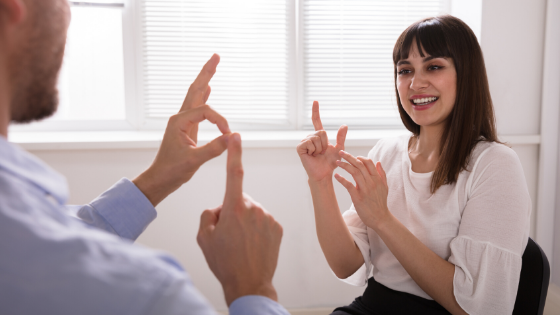


DeepASL could serve as a digital tutor, giving feedback on whether learners are signing correctly. Since more than 90 percent of deaf children are born to parents who are hearing, there is a large community of adults who need to learn ASL quickly. The device, which could be integrated with a phone, tablet or computer, can also help teach ASL, Zhang says. It could be especially useful in emergency situations, Zhang says, when waiting for a translator could cost precious minutes. Zhang and his team hope DeepASL can help people who are deaf and hard of hearing by serving as a real-time translator. “This is a truly non-intrusive technology,” says Mi Zhang, a professor of electrical and computer engineering who lead the research. Unlike many previous devices, DeepASL can translate whole sentences rather than single words, and doesn’t require users to pause between signs. The technology, called DeepASL, uses a camera device to capture hand motions, then feeds the data through a deep learning algorithm, which matches it to signs of ASL. Now, a group of researchers at Michigan State University (MSU) has developed a glove-less device the size of a tube of Chapstick they hope will improve ASL-English translation. Many of these technologies use gloves to capture the motion of signing, which can be bulky and awkward.

So if you need an oral translator for any reason, you know who to contact.Over the past several decades, researchers have regularly developed devices meant to translate American Sign Language (ASL) to English, with the hopes of easing communication between people who are deaf and hard of hearing and the hearing world. Tina is listed on the Expert Witness Register and has won a prestigious award at the Expert Witness Awards. On top of that, Tina is not only an expert lip reader, but she can also lip-read Arabic, German, Japanese, and Spanish. She has been the official oral translator for several public events, including the Royal Weddings of Prince William and Kate Middleton for Sky and Prince Harry and Meghan Markle for the BBC.
Deaf translator professional#
Our founder and MD, Tina Lannin, is one of the world’s foremost experts in professional lip reading. Luckily, here at 121 Captions, we have some of the very best oral translators in the world working for us, all across the world and in multiple languages. If you are looking for an oral translator, no matter which side of the Atlantic you’re on, then your search is over.Īn oral translator is a specialist occupation, with very few people around the world able to do it to an exceptional degree. Reporters and news channels are hiring professionals to see what’s being said by players during games, hoping to find something controversial.Īn oral translator can also be used in medical cases where the patient can’t speak or communicate, freeing up time for healthcare professionals. Lip reading is also now widely used by media outlets, especially for sporting events. To either stop a crime from being committed or to convict/acquit after the fact, lawyers and police officers will use a forensic lip reader to examine the footage and fill in the audio. Many CCTV systems are video only and don’t have the audio to go along with the picture, so reading people’s lips on video is handy for people like lawyers and law enforcement officers. Oral translation isn’t just for deaf and hard of hearing. There is a sub-section of the phrase used rarely to mean someone who translates spoken word to a deaf person via sign language, but again, this is a North American thing and really no different to what is normally regarded as a sign language interpreter. Oral translation is more of an American term, while in the UK we use lip-reader or speechreader. The difference between an oral translator and a lip-reader If you don’t think facial expressions are important in communication, then think about all those poker players wearing sunglasses at the table so as to not give away their hand. This is why it’s often harder to lip read people who are wearing dark glasses, or those who don’t (or can’t) show much facial expression when they talk. In reality, it’s not only watching the lips that makes a good oral translator facial expressions, speech patterns, and hand gestures all play an important role. There are differences, some of which even depend on what country you’re from! What’s an oral translator?Īn oral translator is someone who can tell what a person is saying just by watching their lips move when they are speaking. You may have seen the phrase oral translator and wondered what it means – after all, isn’t an oral translator just a redundant way of saying a translator?


 0 kommentar(er)
0 kommentar(er)
